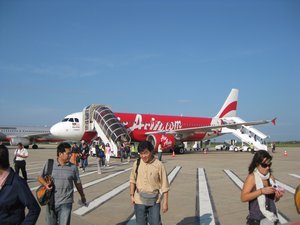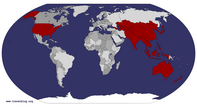Advertisement
Published: November 1st 2009

 image1
image1
Arriving in Siem ReapOur weirdest travel experience so far happened today.
We had a 7am flight to Cambodia on Air Asia, the super discount airline in Asia at the moment. This airline is based in KL and has an extensive flight map and very, very low prices (I think some flights are $10-$30 USD).
Since the international airport is so far from town (50-60 minutes), we woke up at 4am, left the hotel at 4:30am and reached the airport at 5:15am. It was utterly silent. Absolutely nothing going on. Weird. We found a woman half asleep at the info desk and she told us that Air Asia has it's own terminal (actually co-located with the cargo terminal) - on the other side of the massive airfield, about 20 minutes away. Yikes! So we ran down to the taxis, woke up the women snoozing at the ticket desk, bought our ticket and were driven the extra distance to the other terminal, which was buzzing with activity.
Air Asia's business model is high volume, zero frills. And it seems to work for them - we saw about 40 flights listed on the departure screen in a one hour period. Their terminal is a

 image2
image2
Ta Prohmlarge hangar with about 100 check-in counters, each one for a specific flight. It was absolutely packed with people frantically trying to figure out where to check-in, whether or not they needed to have their bags security checked in advance (yes) and how to get to their gate. We managed to get it all taken care of and through the lines to our gate with about 30 minutes to spare (Adrian even had time to have his first encounter with a squatty potty). Once at the gate, passengers are corralled in a waiting area and then, when it's time to board, you're herded across the airfield to your waiting A320. The flight was fine, about 2 hours to Siem Reap, our next destination and home to the famous Angkor Wat temple.
Siem Reap's airport is brand new and very nice. We had taken care of our visas online several weeks ago and breezed through immigration and out to where our hotel's driver was waiting for us.
Siem Reap reminds us both of Central Amercian towns - lush tropical jungle foliage, small houses with thatched roofs and a hot and humid climate.
The Kool Hotel lives up to

 image3
image3
Carvings at Ta Prohmits name. Although it's a bit far from town (15 sweaty minutes of walking or about 8 minutes breezy but lurching ride in a tuk tuk), we love it. Like many hotels in Siem Reap, it's very new (about a year old) and very comfortable. The manager welcomed us, sat us down in the large and beautifully decorated lobby and brought us cold sweet tea, cold towels and a plate of fresh tropical fruits (dragon fruit, bananas, etc). We chatted about what we planned to do with our three days in town and he organized several temple tours for us, the first of which started this morning at 11am.
Our room was ready by 9am and we unpacked and then came down to the restaurant for the very tasty and extensive (and completely complimentary) breakfast. Choices include banana pancakes, breakfast burritos, eggs and bacon, breakfast bagels, oatmeal, fresh fruit, etc. We also began taking our anti-malarial pills today (Malarone for those of you who might be interested in these things).
The room is also very nice - all beautiful teak or mahogany (local woods) and comfy. Bottled water is included (you can't drink the tap water here in

 image4
image4
Ta ProhmCambodia). They have free internet access which seems to work fairly well.
Our adventure began at 11am when our guide, Cheak (pronounced "check") arrived and we drove out to the temples. Angkor Wat is just one of many truly spectacular temples, all built between 900 and 1200 AD (and, unlike many of the temples that we saw in Japan, they are original structures) during the powerful Khmer period. The earlier temples are Hindu; the later ones are Buddhist, although many incorporate elements from both religions.
Our guide told us about the history of the temples - and Cambodia. We start back in about 700 AD when the Khmer empire was on the rise. At its peak in the 1100s, it controlled a large part of Southeast Asia and was centered in Cambodia, and Angkor Wat was its capital. Starting in the 800s AD, the Khmer kings began to build a series of temples. The religion at the time was Hindu and the temples reflected that with many popular Hindu images and stories which are told in elaborate carvings on the local sandstone from which the temples were built. This fascination for building continued and the kings continued to

 image6
image6
Goddess at Ta Prohmbuild enormous temples, each one bigger and more impressive than the last. In the 1200s, Buddhism became the major religion. The temples after that begin to incorporate elements of both Hinduism and Buddhism and Buddhist elements were added to earlier temples. However, the Khmer began to lose power in the late 13th century. Over the next 500 years, the Khmer fought other groups in the region (Burma, Siam - Thailand, Vietnam) and the Khmer Empire's borders were constantly begin redrawn. By the 1800s, Cambodia (Khmer) had shrunk considerably in size. During this time, the temples were all but abandoned, known only to the locals, and great jungles grew up around them. They slumbered for hundreds of years and were only "discovered" by the French in the late 1800s/early 1900s. The jungles were cut back from most of them and only then did the world begin to hear about these amazing structures, which were still in excellent condition given their age.
Sadly, Cambodia's recent history had a devastating effect upon these temples. After rediscovery, and especially within the last 20-30 years, they were looted extensively and the Buddha images throughout the temples were destroyed (the Buddhas were beheaded). The Hindu

 image7
image7
Another goddess at Ta Prohmcarvings and gods were, for the most part, left untouched.
There are many temples ("wat") around Siem Reap that have been cleared of landmines and are therefore on the standard tourist path. Landmines are still a huge problem throughout most of the country - but that's another story. There are many more temples from this time period located in the mountains on the border of Thailand but they are inaccessble at the moment because of ongoing fighting with the Thai and the existence of many landmines that haven't yet been cleared.
We saw three temples today. The pictures tell the story better, so we'll limit the descriptions here.
1. Ta Prohm. This is where parts of Tomb Raider were filmed. Unlike the other temples, it was not cleared of all of the jungle growth around it and so you see these incredible banyan and Khmer Spoong trees growing right up through the stone. It was built in 1186 for the King's mother (apparently, the thing to do back then if you had enough money and power was to build temples in honor of important people in your life, including yourself).
2. Banteay Kdei. This one was built

 image8
image8
Angkor Watjust a few years earlier in 1181, also by King Jayavarman VII, in honor of his teachers.
3. Angkor Wat. This is the most famous temple and you have undoubtedly seen photos of it, if not visited it. It was built in the early 1100s by King Suryavarman II and is a Hindu temple with five large spires and beautiful reflecting pools in front of the main entrance (which makes for a great photo). Many Buddha statues were added later (and then beheaded). Not only is it enormous and beautiful, it was originally dedicated to the Hindu god Vishnu and designed to represent Mount Meru, the center of the universe in Hindu mythology.
This tour took until 3:30pm. October is the very beginning of the tourist season but we saw a fair number of tour groups (Japanese, Koreans) and many Western Europeans and Australians (not as many Americans).
We gratefully returned to the hotel, showered (Siem Reap is a three-shower/day kind of town) and headed down to our hotel's restaurant for a very late lunch of delicious Cambodian food.
A word about prices in Cambodia. First, everything is in US dollars. The local currency, the riel,

 image9
image9
Climbing up into Angkor Watfluctuates constantly and so all transactions are conducted in dollars. We were told that ATMs don't work with foreign banks and credit cards are not accepted many places (we had paid for our hotel in advance using PayPal). So we decided to bring in some dollars. Fortunately, you don't need many. A driver and guide for a full day costs $50 USD. Entrees at most very nice restaurants range from $4-$6. Tuk Tuk rides into town for us were $2. It's definitely a bargain for travelers (our hotel room, one of their larger and nice ones, was $52 USD/night).
Later in the evening we decided to check out the town of Siem Reap. It has a bit of a wild west feel to it. The tuk tuks (a motorcycle pulling an open-air carriage that holds 2-4 people) are everywhere and traffic (although they drive on the right) is crazy. Scooters, cars, tuk-tuks all drive haphazardly according to some system that they all know but we don't. There is no concept of lanes - they all converge together and pull apart and go around each other.
The downtown area is small and most of the bars and restaurants are

 image10
image10
Angkor Watgrouped on or near "Pub Street". We had a quick bite and beer (the local beer, Anchor, is pretty good) at the Red Piano, the restaurant that Angelina Jolie and crew frequented while filming. Then back to the hotel for some relief from the heat and a good sleep.
Advertisement
Tot: 0.13s; Tpl: 0.011s; cc: 9; qc: 52; dbt: 0.0661s; 1; m:domysql w:travelblog (10.17.0.13); sld: 1;
; mem: 1.2mb










